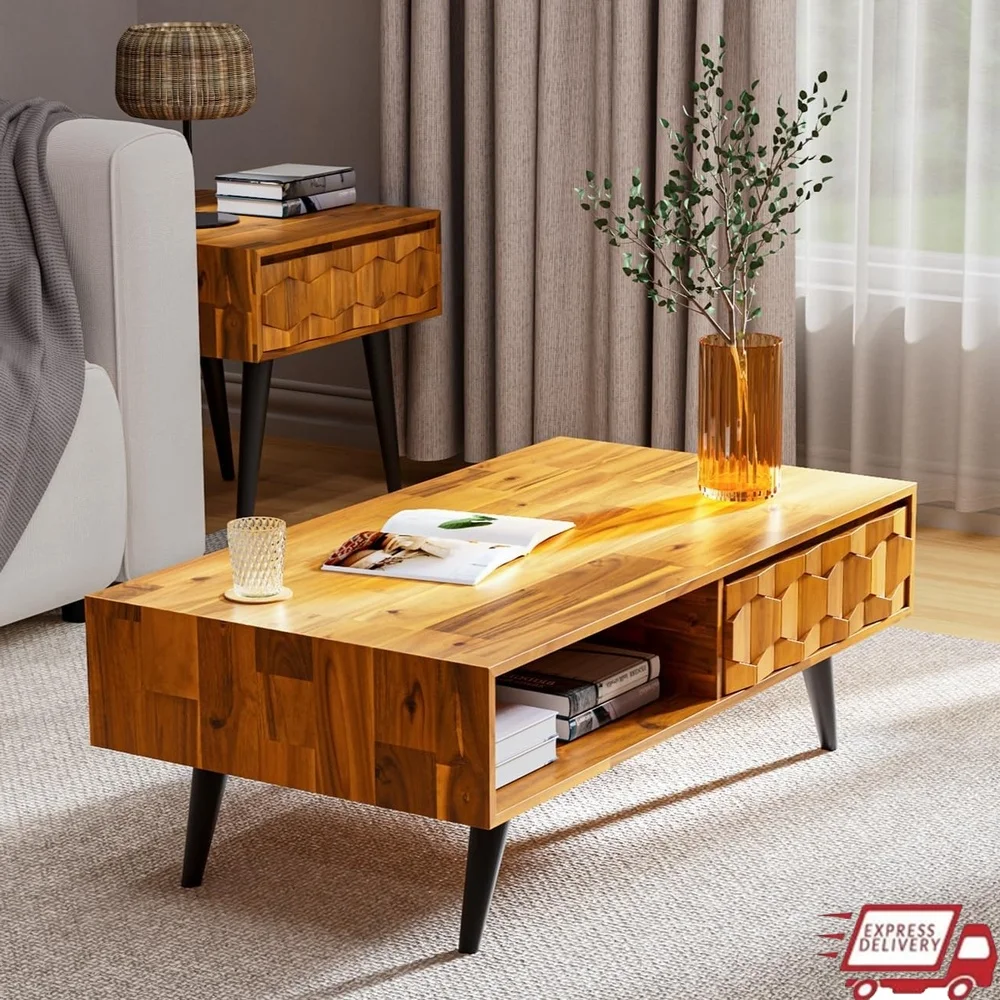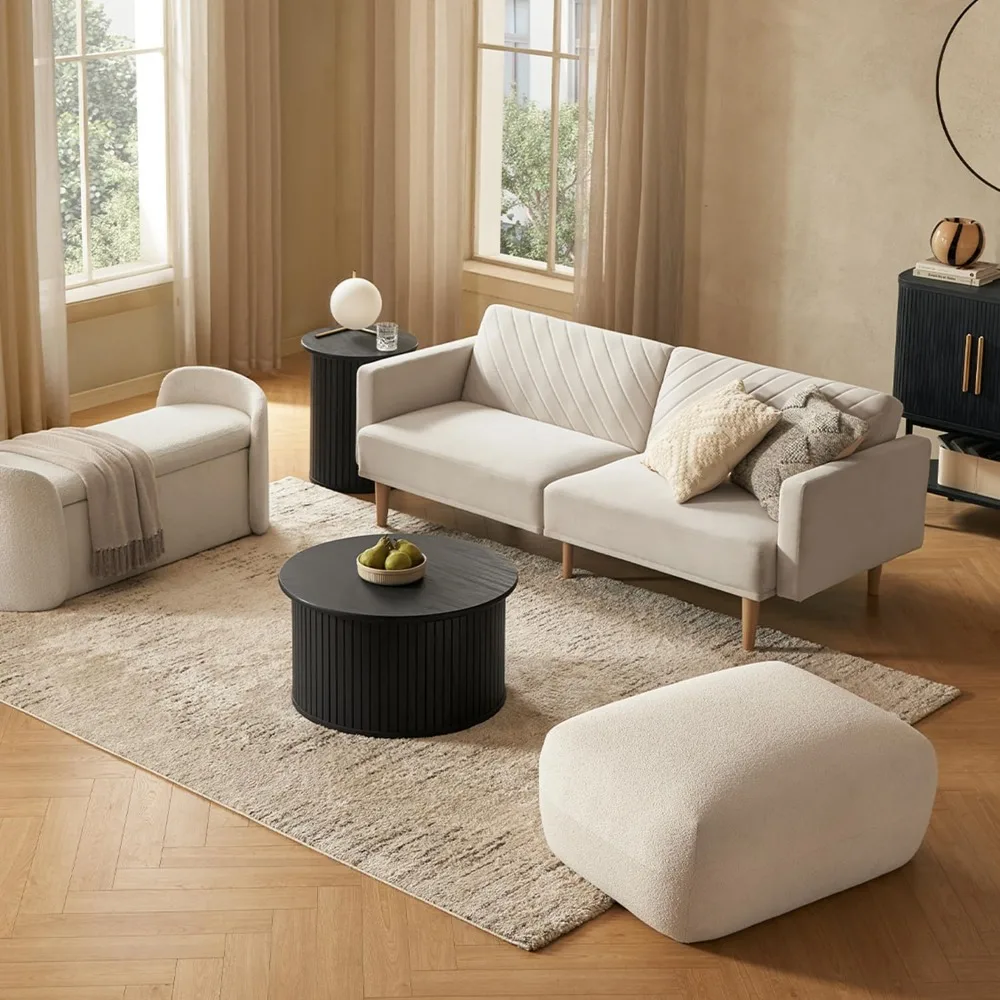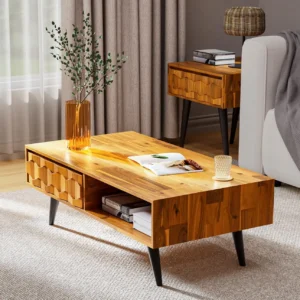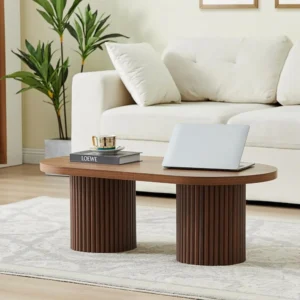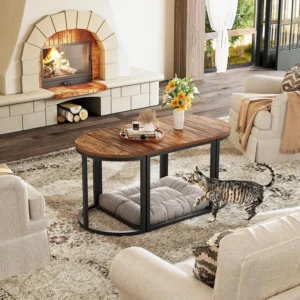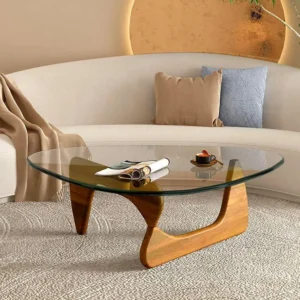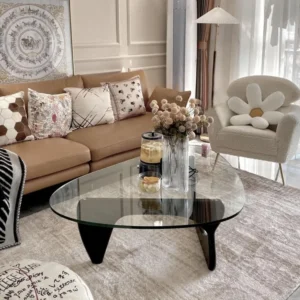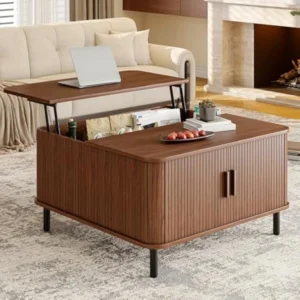Mid-century modern design continues to captivate homeowners and interior designers alike, with its clean lines, functional simplicity, and timeless appeal. Within this beloved aesthetic, black mid-century coffee tables stand as versatile centerpieces that anchor living spaces with both drama and sophistication. These pieces effortlessly blend vintage charm with contemporary relevance, creating a perfect marriage of past and present.
The allure of black as a finish choice for mid-century coffee tables lies in its remarkable versatility. Unlike lighter woods or metals that may seem tied to specific design eras, black creates a dramatic statement while maintaining a neutral presence that works with virtually any color scheme. These tables provide visual weight in airy spaces and add architectural interest without overwhelming a room’s design.
What makes black mid-century coffee tables particularly special is their ability to highlight the quintessential elements of this design movement—organic shapes, clean lines, and functional forms—while offering a contemporary edge. The contrast between the dark finish and the distinctive silhouettes draws attention to the thoughtful proportions and craftsmanship that define genuine mid-century design.
In this guide, we’ll explore:
– Core principles of mid-century coffee table design
– The significance of black within this design movement
– Distinctive shapes and silhouettes
– Signature leg designs that define the style
– Materials and finishes that elevate black mid-century tables
– Functional features that balance form and purpose
– Iconic designs worth knowing
– Selection criteria to find your perfect piece
– Styling approaches to showcase your table
– Care tips to preserve your investment
Whether you’re a dedicated enthusiast of mid-century aesthetics or simply appreciate how these pieces can transform a contemporary space, understanding the nuances of black mid-century coffee tables will help you make informed choices for your home.
Understanding Mid-Century Modern Coffee Table Design: Core Principles
Mid-century modern design emerged as a distinct movement that balanced form and function in perfect harmony. To truly appreciate black mid-century coffee tables, one must first understand the fundamental design principles that define this enduring style.
At its core, mid-century modern coffee table design embraces:
Clean, organic lines and geometric forms: These tables avoid unnecessary ornamentation in favor of honest shapes that let materials and proportions speak for themselves. Whether featuring gentle curves or sharp angles, mid-century tables showcase intentional silhouettes.
Functional minimalism: Every element serves a purpose. There’s nothing superfluous in mid-century design—each component contributes to both the aesthetic appeal and practical use of the piece.
Truth to materials: Mid-century design celebrates the authentic qualities of materials rather than disguising them. Wood grain remains visible even in black-stained pieces, while metal components proudly display their structural properties.
Connection to nature: Despite their modern appearance, mid-century coffee tables often incorporate organic shapes and natural materials, reflecting the era’s renewed appreciation for bringing the outdoors in.
Democratic design: These pieces were originally created to be accessible to average homeowners, balancing quality craftsmanship with production efficiency.
Mid-century coffee tables emerged during a period of significant cultural and technological change. Following World War II, new manufacturing techniques, materials, and a growing middle class with modern tastes created the perfect environment for this forward-thinking yet approachable style to flourish.
The movement drew inspiration from multiple sources—the warmth and craftsmanship of Scandinavian design, the innovation and optimism of American manufacturing, and the minimalist principles of Japanese aesthetics. This global influence contributed to the creation of coffee tables that were simultaneously practical, beautiful, and accessible.
Coffee tables held special importance in mid-century homes, reflecting changing social patterns. As casual entertaining became more common and television entered the American household, the coffee table transitioned from a peripheral piece to a central element in living room design. These tables became functional sculptures that served multiple purposes—display surfaces, conversation pieces, and practical additions to everyday living.
Today’s enduring fascination with mid-century modern coffee tables stems from their remarkable ability to complement nearly any interior style. Their clean lines work equally well in minimalist apartments and eclectic homes, while their human-scaled proportions create inviting living spaces that never feel cold or unapproachable.
The Significance of Black in Mid-Century Modern Design
Black played a fascinating and multifaceted role in original mid-century design, and its application to coffee tables reveals much about the movement’s aesthetic principles. Far from being simply a neutral color choice, black served specific and intentional purposes that enhanced the distinctive qualities of mid-century furniture.
In the context of black mid-century coffee tables, this powerful color works in several important ways:
Creating dramatic contrast: Black establishes a striking visual counterpoint to the warm wood tones so prevalent in mid-century interiors. When used selectively on table bases or as an accent, black draws attention to the sculptural qualities of the piece while allowing wood grain to remain the star. When used as the primary finish, it creates a bold foundation that allows colorful accessories or upholstery to shine.
Emphasizing form over surface: By minimizing surface variation, black finishes direct attention to the overall silhouette and structural elements of a coffee table. The eye follows the clean lines, organic curves, and thoughtful proportions rather than getting distracted by wood grain patterns or color variations.
Adding sophistication and visual weight: Black lends a certain gravitas and architectural quality to lightweight, floating designs. It grounds airy pieces and creates a sense of substance without requiring bulky proportions or heavy materials.
Enhancing material interactions: When black is applied to just one element of a coffee table—perhaps the base or legs—it creates fascinating dialogues between materials. A black-finished metal base supporting a wood top highlights the contrast between industrial and natural elements, a key tension explored throughout mid-century design.
Providing versatile pairing options: Black’s neutral quality made it particularly valuable in mid-century design, as it allowed furniture to adapt to evolving interior color schemes. This versatility contributes to why black mid-century coffee tables remain relevant decades after their initial design.
The implementation of black varied by designer and region. While some embraced high-gloss piano-like finishes that reflected the era’s fascination with new manufacturing techniques, others preferred matte or textured blacks that revealed the material beneath. Some designers used black to create graphic, high-contrast statements, while others employed it more subtly to outline and define structural elements.
Understanding how black coffee tables function in mid-century interiors helps explain their continued popularity. These pieces ground spaces with their visual presence while still maintaining the lightness and accessibility that makes mid-century design so appealing for contemporary living.
Distinctive Shapes: The Silhouettes of Black Mid-Century Coffee Tables
The shape of a mid-century coffee table is perhaps its most defining characteristic, revealing much about both its practical function and design philosophy. When rendered in black, these distinctive silhouettes take on additional drama and presence, creating focal points that anchor living spaces with architectural interest.
Rectangular
The classic rectangular coffee table represents the most traditional approach to mid-century design. These pieces typically feature balanced proportions with lengths approximately twice their width. In black, rectangular tables provide a strong horizontal element that echoes architectural features like windows and built-ins.
Best for: Larger seating arrangements, especially those with standard sofas. The parallel lines of a rectangular table naturally complement the straight lines of traditional seating.
Design impact: Creates order and symmetry, providing a grounding element that organizes the surrounding space.
Round
Round mid-century coffee tables inject a sense of movement and flow into living spaces. Free from sharp corners, these pieces facilitate easy circulation and conversation, making them perfect for social settings. Black round tables create a compelling visual contrast when placed amidst angular furniture.
Best for: Conversation areas, smaller spaces, or rooms with multiple traffic patterns. Round tables naturally encourage gathering and interaction.
Design impact: Softens a room dominated by straight lines and rectangular elements while adding rhythmic visual interest.
Oval
Oval mid-century coffee tables offer a sophisticated hybrid that combines the flow of round tables with the functional surface area of rectangular designs. Their elongated shape works well with both traditional and curved seating arrangements.
Best for: Balancing spaces with both angular and curved elements, or providing a larger surface without the severity of corners.
Design impact: Creates dynamic visual tension between straight and curved elements while maintaining elegant proportions.
Square
Square coffee tables bring mathematical precision and modern symmetry to living spaces. In black, these geometric forms create powerful focal points that organize the surrounding furniture into a cohesive arrangement.
Best for: Sectional arrangements, square rooms, or spaces where equal access from multiple sides is important.
Design impact: Establishes a sense of order and intentional design through perfect symmetry.
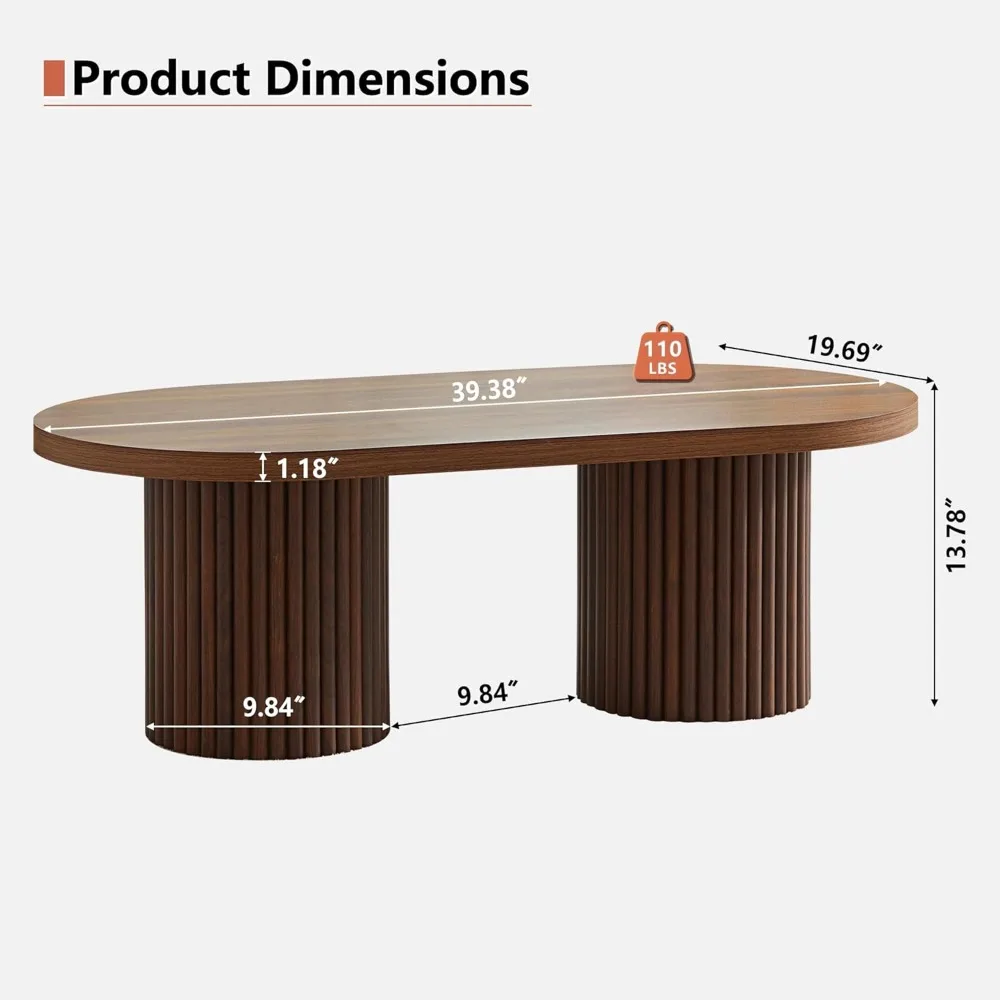
Organic/Free-form
Perhaps the most expressive category, organic or free-form tables reject geometric constraints in favor of flowing, asymmetrical shapes inspired by nature. When finished in black, these sculptural pieces become artistic statements that celebrate the more playful side of mid-century design.
Best for: Creative interiors where the coffee table serves as a conversation piece, or spaces that benefit from softening through non-geometric forms.
Design impact: Introduces an element of artistic expression and unpredictability into otherwise ordered spaces.
Triangular
Triangular or three-sided tables represent a bold geometric choice that adds dynamic energy to living areas. Their unexpected angles create visual interest and can fit ingeniously into challenging space constraints.
Best for: Corner arrangements, small spaces that benefit from space-saving designs, or rooms that need an element of surprise.
Design impact: Introduces directional energy and unconventional geometry that draws the eye.
Nesting Tables
Sets of nesting coffee tables epitomize the mid-century commitment to flexibility and functionality. These adaptable pieces can be arranged in countless configurations to serve different needs. In black, the graduated sizes create an appealing rhythm of repeating forms.
Best for: Multi-functional spaces, small apartments where adaptability is crucial, or homes where entertaining needs vary widely.
Design impact: Offers visual complexity through layering and provides practical versatility through reconfigurable elements.
The shape of a black mid-century coffee table not only determines its practical functionality but also profoundly influences the visual and emotional experience of a space. The various black mid-century modern coffee table styles available today offer something for every taste and interior approach, from strictly geometric to organically flowing.
Signature Leg Designs: Foundations of Mid-Century Style
The legs and supports of mid-century coffee tables are not merely functional elements—they’re defining design features that embody the era’s engineering innovation and aesthetic principles. When rendered in black, these distinctive support structures gain additional graphic impact, creating visual drama through contrast and silhouette.
Tapered Legs
Perhaps the most recognizable mid-century leg design, tapered legs start wider at their connection point and narrow as they extend to the floor. This subtle detail creates a sense of lightness and elegance while maintaining structural integrity.
Design characteristics: Typically set at an angle (splayed) rather than perfectly vertical, creating a sense of dynamic tension and visual interest. Most commonly seen in wood but also adapted to metal in some designs.
Visual impact: Suggests upward movement and creates a sense that the table is “lifting” from the floor, contributing to the floating quality prized in mid-century design.
Material considerations: Black-stained wooden tapered legs highlight the sculptural quality of this design approach, while black-painted metal versions offer a more industrial interpretation.
Hairpin Legs
Born from industrial design and material efficiency, hairpin legs use minimal metal rods bent into elegant shapes to support table surfaces. Black hairpin legs offer exceptional visual lightness while providing surprising strength.
Design characteristics: Typically made from metal rods bent into V or M formations, creating strength through geometric principles rather than bulk.
Visual impact: Creates negative space beneath the table surface, allowing light and views to flow through the piece, making it ideal for smaller spaces.
Material considerations: Almost exclusively crafted in metal, black hairpin legs offer crisp definition and industrial character that contrasts beautifully with wood, glass, or stone tops.
Sled Legs and Plinth Bases
For a more substantial approach, some mid-century coffee tables feature continuous bases that create a solid foundation. These may take the form of sled-style supports that curve from floor to tabletop in one flowing line, or plinth bases that provide a platform-like structure.
Design characteristics: Emphasizes horizontal lines and creates a sense of stability and permanence. Often incorporates bent plywood technology or solid wood craftsmanship.
Visual impact: Grounds the piece visually and physically, creating a sense of substance and architectural presence.
Material considerations: Black-finished sled bases highlight the continuous curve of the design, while black plinth bases create a strong shadow line between floor and table.
Sculptural Bases
Some of the most distinctive mid-century coffee tables feature artistic, sculptural bases that blur the line between furniture and art. These expressive supports often incorporate organic shapes, asymmetry, or unexpected geometries.
Design characteristics: Prioritizes visual impact and unique form, often featuring shapes inspired by natural elements or abstract art movements of the period.
Visual impact: Transforms the table into a conversation piece where the base may be more visually important than the surface it supports.
Material considerations: Black sculptural bases emphasize the play of light and shadow across complex forms, highlighting the three-dimensional qualities of the design.
The various features of black mid-century coffee tables work together to create cohesive designs, but the leg structure often provides the most immediate visual cue to a table’s design heritage and philosophy. Understanding these distinctive approaches helps identify authentic mid-century pieces and appreciate the engineering ingenuity behind their enduring appeal.
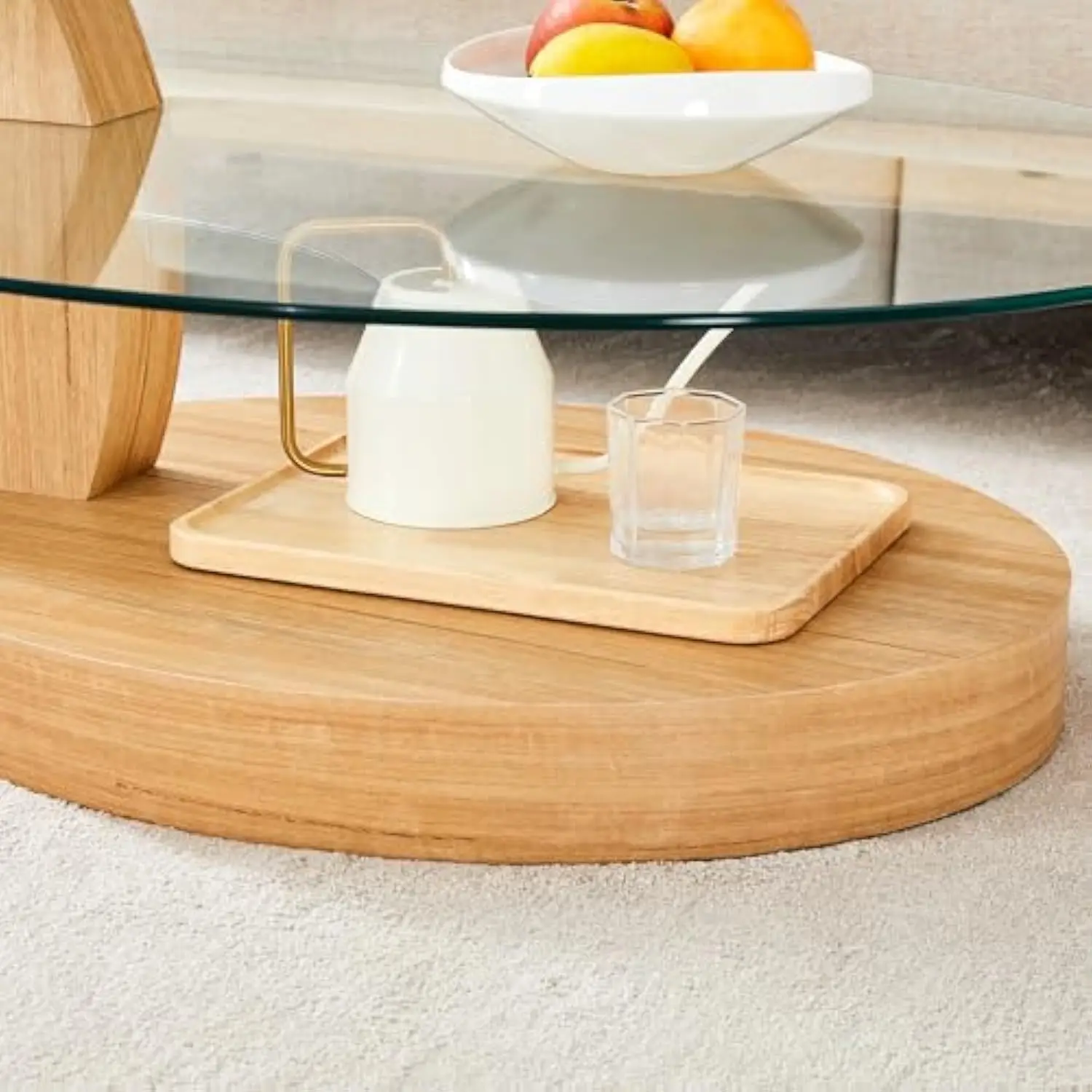
Materials and Finishes: The Elements of Black Mid-Century Tables
The materiality of black mid-century coffee tables reveals much about both their authentic design heritage and their practical durability. While “black” might seem straightforward as a color description, mid-century pieces achieve this finish through various materials and techniques, each creating distinct visual and tactile effects.
Wood in Black
Wood remains the most traditional material for mid-century tables, with several approaches to achieving black finishes:
Black-stained natural woods: Many mid-century pieces use rich ebony stains that allow some of the wood grain to remain visible. This technique preserves the organic quality of the material while adding dramatic depth. Teak, walnut, and oak were particularly popular for this treatment.
Visual characteristics: Creates depth and subtle variation as light plays across the surface, revealing hints of the grain pattern beneath.
Durability factors: Generally quite durable but can show scratches that reveal lighter wood underneath. Quality pieces develop a beautiful patina over time.
Maintenance needs: Requires occasional polishing with appropriate wood care products. Avoid direct sunlight to prevent uneven fading.
Ebonized wood: This traditional technique uses tannic acid reactions or specialized finishes to create deep black coloration that penetrates more deeply than standard stains.
Visual characteristics: Creates an especially rich, deep black that still maintains wood character.
Durability factors: More resistant to showing scratches than simple stained finishes.
Maintenance needs: Similar to other fine wood furniture, requiring protection from moisture and heat.
Black-painted wood: Some mid-century designs used paint rather than stain, especially on secondary elements or less expensive production pieces.
Visual characteristics: Creates a more uniform, contemporary appearance with less visible wood character.
Durability factors: Can chip or show wear at edges and high-contact areas.
Maintenance needs: Occasionally requires touch-ups at wear points. More forgiving of cleaning products than natural wood finishes.
Glass Tabletops
Glass surfaces create striking contrast with black bases or frames:
Clear glass with black bases: This classic combination emphasizes the sculptural quality of black table bases while maintaining visual lightness.
Visual characteristics: Creates an airy, open feel while drawing attention to the design of the base.
Durability factors: Tempered glass offers good resistance to breakage but can scratch over time.
Maintenance needs: Requires regular cleaning to maintain transparency. Fingerprints and dust are more visible than on other surfaces.
Smoked or black glass: More dramatic than clear glass, these darker surfaces create sophisticated, reflective planes that add depth to a room.
Visual characteristics: Creates subtle reflections and adds a sleek, contemporary feel.
Durability factors: Shows fewer fingerprints and minor scratches than clear glass.
Maintenance needs: Similar to clear glass but more forgiving of dust and smudges.
Metal Elements
Metal components in black finishes add industrial character to mid-century tables:
Black powder-coated metal: This durable finishing technique creates a consistent matte or semi-gloss surface on metal parts.
Visual characteristics: Provides uniform color with a contemporary feel.
Durability factors: Highly resistant to chipping and scratching when properly applied.
Maintenance needs: Simple to clean with mild soap and water. Avoid abrasive cleaners.
Blackened or patinated metal: These more artisanal approaches create rich, variable black finishes with subtle blue or brown undertones.
Visual characteristics: Creates depth and character that changes subtly with age and use.
Durability factors: Develops an evolving patina that generally enhances rather than detracts from the piece.
Maintenance needs: May require occasional waxing or specialized care to maintain finish.
Stone and Marble
Natural stone elements pair beautifully with black components:
Black marble or granite tops: These luxurious natural materials add rich texture and organic patterning to coffee tables.
Visual characteristics: Each piece features unique veining and character. Provides a cool, substantial surface.
Durability factors: Resistant to heat but can stain if not properly sealed. May chip at edges.
Maintenance needs: Requires periodic resealing and careful cleaning with appropriate stone products.
Contrasting stone with black bases: Light-colored stone or marble tops paired with black bases create dramatic visual tension.
Visual characteristics: Creates a sophisticated balance between light and dark elements.
Durability factors: Similar to other stone surfaces, depends on proper sealing and care.
Maintenance needs: May show etching from acidic substances if not promptly cleaned.
Engineered Materials
Contemporary interpretations sometimes incorporate modern materials:
Black engineered surfaces: Materials like high-pressure laminate or solid surface materials offer practical alternatives to natural materials.
Visual characteristics: Provides consistent color and texture without the variation of natural materials.
Durability factors: Generally highly resistant to staining, scratching, and heat damage.
Maintenance needs: Easy to clean with standard household products. Very forgiving for everyday use.
The materials and finishes of black mid-century coffee tables significantly impact not just their appearance but also their longevity and maintenance requirements. When selecting a piece for your home, consider how these material choices align with both your aesthetic preferences and lifestyle needs.

Functional Features: Storage and Adaptability in Black Mid-Century Tables
Mid-century design brilliantly balances form and function, and nowhere is this more evident than in the thoughtful storage and adaptability features integrated into many coffee tables of the period. Black mid-century coffee tables often incorporate clever functional elements that enhance their usefulness without compromising their clean aesthetic.
Integrated Storage Solutions
Many mid-century coffee tables incorporate discreet storage that maintains the piece’s streamlined appearance:
Drawers and compartments: Hidden drawers—sometimes with ingenious push-release mechanisms—provide perfect storage for remote controls, magazines, or small items that might otherwise clutter the surface.
Open shelving: Many designs feature a second surface beneath the tabletop, creating display space for books or storage for larger items while maintaining visual lightness.
Divided compartments: Some tables include thoughtfully divided storage areas specifically designed for records, magazines, or other media—reflecting the era’s attention to emerging entertainment needs.
The black finish on these storage elements often creates sophisticated visual effects. When drawers or compartments are rendered in black, they can either blend seamlessly with a black table body or create striking contrast against lighter wood elements. This interplay between visible and concealed components adds visual depth while maintaining clean lines.
Lift-Top Functionality
Lift-top coffee tables represent a brilliant functional innovation that has gained renewed popularity in contemporary interpretations of mid-century design:
Adjustable heights: The lifting mechanism allows the surface to rise to a comfortable working height, creating an instant desk or dining surface.
Hidden storage: The space revealed beneath the lifting surface provides concealed storage for items not in constant use.
Multi-tasking potential: These adaptable pieces accommodate various activities—from laptop work to casual dining—without requiring additional furniture.
Black lift-top tables create particularly dramatic effects when the mechanism is engaged, as the moving elements create new planes of light and shadow. The contrast between the lifted surface and the stationary base adds visual interest while serving practical needs.
Nesting and Expandable Designs
Space efficiency was a core consideration in mid-century design, leading to ingenious solutions for flexible use:
Nesting tables: Sets of nesting coffee tables can be separated to serve multiple areas or grouped together to create layered visual interest. When finished in black, these graduated pieces create a compelling rhythm through repeating forms.
Expandable designs: Some tables feature extending elements or transforming components that adapt to different needs. These mechanical innovations showcase the era’s fascination with versatile functionality.
Modular components: Some designs feature separate units that can be arranged in various configurations, offering flexibility for different spaces or uses.
Multi-Level Surfaces
Many mid-century coffee tables incorporate multiple planes at different heights:
Tiered designs: These create natural organization for different types of items while adding visual complexity.
Split-level surfaces: Different areas at slight height variations define zones for different activities or display purposes.
Sculptural level changes: Some designs use dramatic level changes as artistic elements that double as functional divisions.
In black finishes, these multi-level designs gain additional impact as the different planes create sharp shadow lines and visual definition. The contrast between surfaces highlights the thoughtful engineering behind these practical features.
The integration of these functional elements demonstrates how mid-century design anticipated modern living needs while maintaining aesthetic integrity. Today’s interpretations of these pieces continue this tradition, offering practical solutions for contemporary challenges while honoring the clean lines and honest materials that define the style. The best black mid-century coffee tables don’t force users to choose between beauty and utility—they seamlessly deliver both.
Mid-Century Modern Solid Wood Coffee Tables, Mid-Century Modern Teak Coffee Tables
$879.95 Select options This product has multiple variants. The options may be chosen on the product pageMid-Century Modern Danish Coffee Tables, Mid-Century Modern Oval Coffee Tables, Mid-Century Modern Solid Wood Coffee Tables
$390.05 Select options This product has multiple variants. The options may be chosen on the product pageMid-Century Modern Coffee & End Table Sets, Mid-Century Modern Coffee Table Sets, Mid-Century Modern Oval Coffee Tables
Price range: $257.48 through $331.04 Select options This product has multiple variants. The options may be chosen on the product pageMid-Century Modern Glass Top Coffee Tables, Mid-Century Modern Glass Top Side & End Tables
$460.58 Select options This product has multiple variants. The options may be chosen on the product pageMid-Century Modern Glass Top Coffee Tables, Mid-Century Modern Vintage Coffee Tables, Mid-Century Modern Vintage Side & End Tables
$725.36 Select options This product has multiple variants. The options may be chosen on the product pageMid-Century Modern Lift Top Coffee Tables, Mid-Century Modern Square Coffee Tables
$454.73 Select options This product has multiple variants. The options may be chosen on the product page
Iconic Black Mid-Century Coffee Table Designs
The mid-century period produced numerous coffee table designs that have achieved iconic status, many of which look particularly striking when executed in black finishes. Understanding these influential styles helps appreciate the design heritage behind contemporary pieces and recognize quality interpretations in today’s market.
Sculptural Three-Legged Designs with Glass Tops
Among the most recognizable mid-century silhouettes are tables featuring three sculptural legs supporting a glass top. This approach creates a sense of visual lightness while highlighting the organic, sculptural qualities of the base.
Design characteristics: Three legs, often with organic curves or angular geometry, supporting a round or triangular glass surface. The asymmetrical base creates dynamic visual tension.
Material combinations: Typically features wood legs with clear glass tops, though black-finished wood or metal bases offer particularly dramatic presentations.
Enduring appeal: The combination of stability (three points always create a stable plane) with artistic expression exemplifies mid-century design’s balance of engineering and aesthetics.
Contemporary adaptations: Modern versions may incorporate sustainable woods or reinforced glass while maintaining the essential silhouette.
Platform-Style Multipurpose Benches/Tables
These versatile pieces blur the line between coffee table and bench, typically featuring a rectangular form with minimal height.
Design characteristics: Long, low profile with clean lines and minimal ornamentation. Often incorporates a floating top or visible structural elements.
Material combinations: Solid wood construction is most common, with black finishes highlighting the architectural simplicity of the form.
Enduring appeal: The versatility and understated elegance of these pieces make them incredibly adaptable to various interior styles.
Contemporary adaptations: Modern interpretations often add subtle storage elements or material combinations while preserving the essential horizontal emphasis.
Wire-Base Designs with Laminate or Glass Tops
Influenced by industrial design and new manufacturing capabilities, these tables feature geometric metal bases supporting simple tops.
Design characteristics: Complex wire or rod structures creating geometric patterns beneath simple surface planes.
Material combinations: Black-finished metal bases with glass, wood, or laminate tops create striking contrasts between industrial and refined elements.
Enduring appeal: The mathematical precision and visual transparency make these pieces appear both substantial and weightless simultaneously.
Contemporary adaptations: Modern versions often feature strengthened welding techniques and more durable finishes while maintaining the airy aesthetic.
Molded Plywood Organic Forms
Showcasing technological innovations in wood forming, these pieces feature fluid, continuous shapes created through advanced lamination techniques.
Design characteristics: Sinuous, flowing forms with minimal visible joints or hardware, often creating the impression of a sculpted rather than constructed piece.
Material combinations: Typically executed in wood with black stain or paint highlighting the organic contours.
Enduring appeal: The seamless integration of advanced technology with natural materials creates pieces that feel simultaneously innovative and timeless.
Contemporary adaptations: Modern manufacturing allows for more consistent production while maintaining the organic aesthetic.
Minimalist Rectangular Designs with Tapered Legs
Perhaps the most adaptable and widely recognized mid-century form, these straightforward tables embody the movement’s commitment to honest simplicity.
Design characteristics: Clean rectangular tops with minimal ornamentation supported by tapered legs, often set at an angle.
Material combinations: Solid wood construction is traditional, with black finishes providing a more dramatic presentation than natural wood tones.
Enduring appeal: The straightforward functionality and perfect proportions make these pieces endlessly adaptable to various interior styles.
Contemporary adaptations: Modern versions may incorporate subtle storage elements or sustainable materials while preserving the essential clean lines.
Each of these iconic styles appears in the collections of best black mid-century coffee tables available today, whether as faithful reproductions or contemporary interpretations. The enduring popularity of these designs speaks to their exceptional balance of form and function—a balance that continues to resonate with today’s interior aesthetics despite being developed decades ago.
These influential designs don’t merely represent historical artifacts; they continue to shape our understanding of what makes furniture both useful and beautiful. The best contemporary black mid-century coffee tables honor this legacy through quality materials, thoughtful proportions, and attention to functional details.
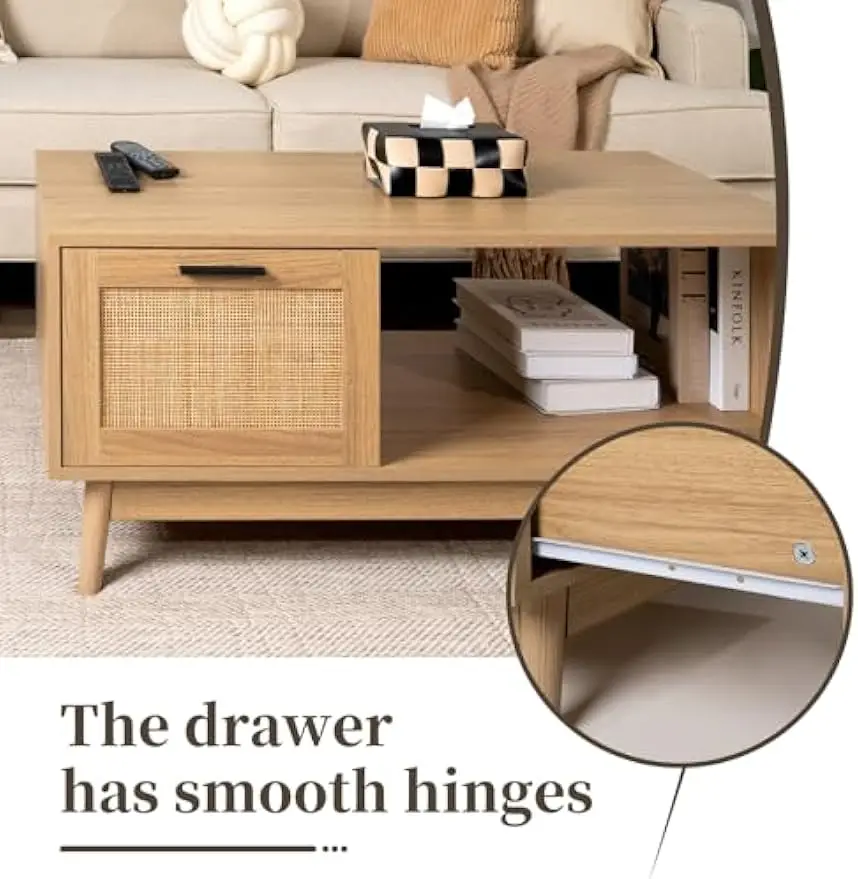
Selecting the Perfect Black Mid-Century Coffee Table: A Buyer’s Guide
Finding the ideal black mid-century coffee table involves balancing aesthetic preferences with practical considerations. This comprehensive guide will help you navigate the selection process with confidence.
Size and Proportion Guidelines
Proper sizing ensures your coffee table functions well within your space while maintaining visual harmony:
Table-to-sofa ratio: Aim for a coffee table length that’s approximately two-thirds the length of your sofa. This creates balanced proportions without overwhelming the seating area.
Height considerations: The ideal coffee table sits 1-2 inches below your sofa seat height for comfortable use. Most mid-century coffee tables range from 16-19 inches tall, aligning perfectly with typical sofa dimensions.
Clearance requirements: Maintain 18-24 inches between your coffee table and surrounding seating. This provides comfortable legroom while keeping the table within easy reach.
Room scale awareness: In smaller spaces, consider round or oval tables that facilitate movement around them. Larger rooms can accommodate more substantial rectangular pieces or groupings of nesting tables.
Visual weight: Black coffee tables have stronger visual presence than lighter finishes. In smaller spaces, consider designs with glass elements or elevated bases that create a sense of openness.
Material Considerations Based on Lifestyle
Different households have varying needs that should inform material selection:
For active households with children:
– Consider black-painted or laminate surfaces that resist staining
– Avoid glass tops or sharp corners
– Look for sturdy construction that can withstand climbing or roughhousing
– Prioritize easily cleanable surfaces
For design-focused adults:
– Authentic wood with black finishes offers rich character that evolves beautifully with age
– Glass tops showcase sculptural bases while maintaining visual lightness
– Consider how the finish interacts with lighting in your space
– Match material durability to expected use intensity
For multi-function spaces:
– Seek surfaces resistant to heat and moisture if the table will serve dining functions
– Consider storage options if the table needs to accommodate work materials
– Evaluate edge details for comfort if the table will serve as occasional seating
For pet owners:
– Avoid highly reflective surfaces that show scratches easily
– Consider materials that resist claw marks
– Choose finishes that can be touched up if damaged
Functionality Requirements
Assess how your coffee table needs to perform beyond basic surface functions:
Storage assessment:
– Evaluate what items you regularly need to access in your seating area
– Consider tables with drawers for small items like remote controls
– Look for shelving if you display books or magazines
– Determine if concealed or visible storage better suits your organization style
Surface requirements:
– Calculate how much usable surface area you need for typical activities
– Consider if drink placement is a primary function
– Evaluate if you’ll use the table for casual dining or work
– Determine if multiple smaller surfaces (like nesting tables) might serve better than one large surface
Multi-functional considerations:
– Assess whether lift-top functionality would add value for your lifestyle
– Consider if the table needs to serve as occasional seating
– Evaluate if the piece needs to be easily movable for floor activities or cleaning
– Determine if the table will need to adapt to different furniture arrangements
Aesthetic Compatibility
Your black mid-century coffee table should enhance your overall interior design:
Integration with various styles:
– Modern and contemporary: Black mid-century tables add warmth and character to sleek, minimal spaces
– Traditional: Create appealing tension between classic and modern elements
– Eclectic: Provide a grounding element amid diverse textures and colors
– Industrial: Complement raw materials with refined mid-century lines
Visual weight balancing:
– In light-colored rooms, black tables create dramatic anchoring points
– With dark flooring, consider tables with some lighter elements to create separation
– Balance the table’s substantiality with your other furniture pieces
Coordination with existing furniture:
– Note the undertones in your black finish (cool vs. warm black) to match with other elements
– Consider how the table’s design complements your seating pieces
– Evaluate whether the table should stand out as a focal point or blend harmoniously
Authenticity and Budget Considerations
Navigate the range of options available at different price points:
Vintage authentic pieces:
– Generally the most expensive option but may hold or increase value
– Require careful evaluation for condition and restoration needs
– Offer unique character and proven durability
– Often feature superior materials and craftsmanship
Quality reproductions:
– Provide faithful interpretations of classic designs
– Offer the advantage of pristine condition
– Generally more accessible price point than vintage
– May use updated materials for durability
Inspired contemporary pieces:
– Incorporate mid-century design principles without directly copying specific designs
– Often feature modern improvements in functionality
– Provide the best value for quality at moderate price points
– Balance authenticity with practical modern needs
When selecting solid wood coffee tables in black finishes, examine construction quality closely. Look for proper joinery, consistent finishes, and attention to detail in both visible and hidden areas. Quality pieces should feel substantial and stable without excessive weight, demonstrating the efficient material use characteristic of genuine mid-century design.
The perfect black mid-century coffee table balances aesthetic appeal with practical function, enhancing your space while serving your specific lifestyle needs. By carefully evaluating these considerations, you’ll find a piece that provides lasting satisfaction and becomes an enduring element of your home’s design story.
Styling Your Black Mid-Century Coffee Table: Design Approaches
A black mid-century coffee table provides an ideal canvas for expressing your personal style while anchoring your living space. The following approaches will help you maximize both the visual impact and functionality of your table.
Using the Table as a Focal Point
Black mid-century coffee tables naturally draw the eye, making them perfect focal elements:
Create visual balance: Arrange seating to frame the table, allowing it to become the central element that ties the arrangement together.
Consider sight lines: Position your most striking objects or arrangements to be visible from primary seating positions.
Use lighting strategically: Direct lighting (like a floor lamp with adjustable arm) can highlight your coffee table display, enhancing its focal presence.
Play with contrast: The dark surface of a black coffee table makes light objects pop—use this to draw attention to special pieces or seasonal displays.
Creating Visual Balance with Accessories
The right arrangement transforms your table from simple furniture to design statement:
Apply the rule of three: Group objects in odd numbers (especially threes) for visual interest and balance. This might include a stack of books, a decorative object, and a small plant.
Create height variation: Include objects at different heights to create dynamic visual flow across the table surface. A tall candlestick or vase can add vertical interest alongside lower elements.
Balance organic and geometric: Combine angular objects (books, trays) with curved or organic forms (bowls, plants) to create tension and interest.
Consider negative space: Don’t overcrowd your table—empty space helps emphasize your carefully chosen objects and maintains functionality.
Complementary Materials and Textures
The right material pairings enhance the sophistication of black mid-century tables:
Warm metallic accents: Brass, copper, or gold objects create luxurious contrast against black surfaces, adding warmth and reflectivity.
Natural elements: Stone objects, wooden bowls, or fresh greenery introduce organic texture that softens the table’s geometric lines.
Ceramic and glass: Matte ceramics or crystal glassware create interesting textural contrasts with the table surface.
Textile accents: Small textile elements like coasters, runners, or small cushions add softness and color to hard surfaces.
Practical Styling That Maintains Functionality
Beautiful styling shouldn’t compromise your table’s usefulness:
Use trays strategically: Corral small objects on trays that can be easily moved when you need the full table surface.
Create zones: Designate areas for practical items (remotes, coasters) and decorative elements to maintain organization.
Scale appropriately: Choose accessories that don’t overwhelm the table’s proportions—especially important for smaller coffee tables.
Consider clearance: Maintain open spaces near seating areas where guests can place drinks or personal items.
Creating Contrast Against Black Surfaces
The dark background of your table provides opportunities for striking visual effects:
High-contrast objects: White, cream, or light-colored items create dramatic definition against black surfaces.
Reflective elements: Mirrored or metallic objects catch and play with light, adding dimension to dark surfaces.
Textured pieces: Items with pronounced texture create subtle shadow play across dark backgrounds, adding visual depth.
Transparent objects: Glass or acrylic pieces create fascinating interactions with black surfaces beneath them.
Seasonal Updates and Versatility
Keep your styling fresh by embracing seasonal changes:
Rotate accessories: Maintain a collection of objects that can be exchanged to refresh your table’s appearance without major investment.
Incorporate seasonal elements: Small seasonal touches—spring blooms, autumn leaves, winter greenery—keep your space feeling current.
Adjust for occasions: Develop alternative arrangements for entertaining that maximize surface space while maintaining visual appeal.
Document successful arrangements: Take photos of arrangements you particularly like for easy recreation later.
Styling a black mid-century coffee table offers endless creative opportunities. The table’s clean lines and architectural presence provide an ideal foundation for displays that can range from minimalist to eclectic. By thoughtfully decorating your black mid-century coffee table with objects that reflect your personality and interests, you transform a functional piece into a curated expression of your personal style.
Remember that the most successful coffee table styling balances beauty with practicality—creating arrangements that delight the eye while accommodating the table’s everyday use as a surface for drinks, books, remote controls, and occasional feet.
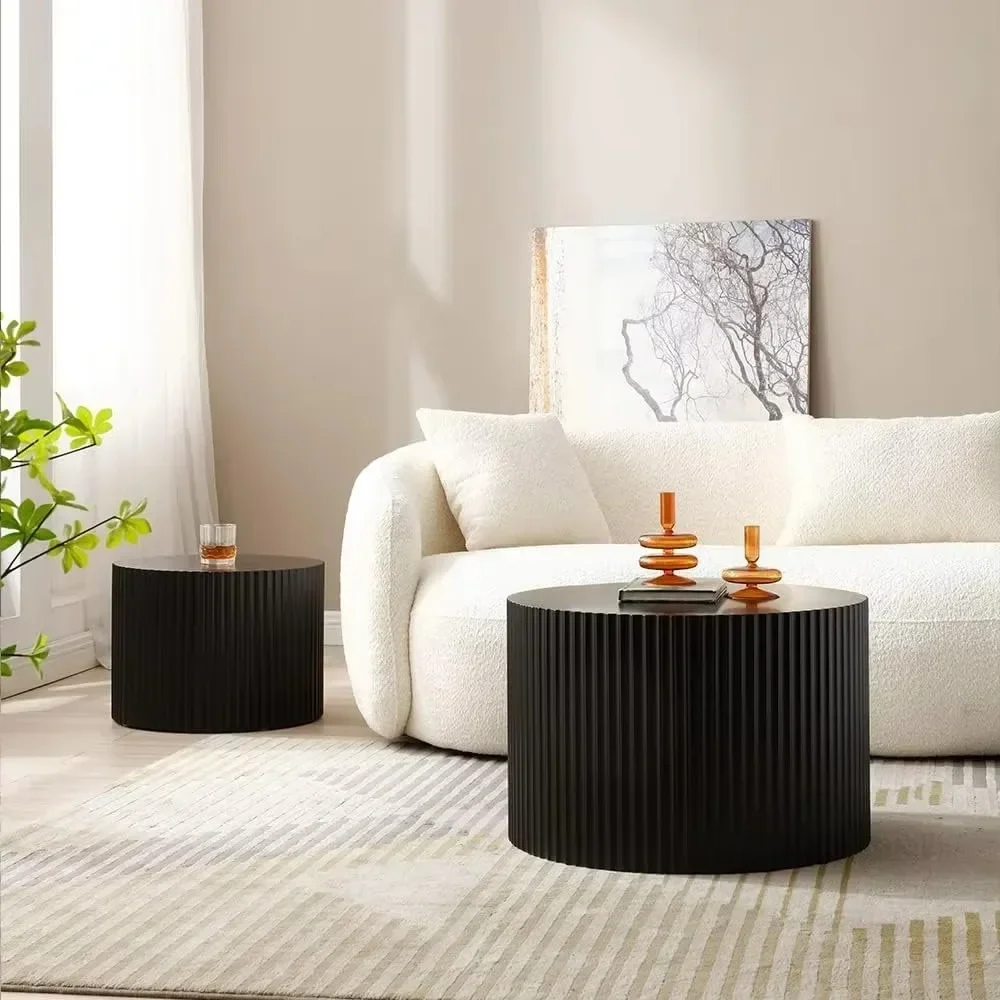
Where to Source Quality Black Mid-Century Coffee Tables
Finding the perfect black mid-century coffee table involves knowing where to look for different options, from authentic vintage pieces to quality contemporary interpretations. Each source category offers distinct advantages and considerations.
Vintage and Antique Sources
For collectors and enthusiasts seeking authentic period pieces:
Specialty retailers and curated vintage shops:
These businesses specialize in finding, restoring, and authenticating genuine mid-century furniture. Their expertise helps ensure you’re getting authentic pieces in good condition.
Price range: Generally the highest option, particularly for pieces by recognized designers or manufacturers
Quality expectations: Should be thoroughly vetted, with any restoration work professionally completed
Advantages: Expert guidance, authentication, and often some form of guarantee or return policy
Online marketplaces for authentic pieces:
Various online platforms connect sellers of genuine vintage furniture with buyers. These range from curated sites with dealer verification to open marketplaces requiring more buyer diligence.
Price range: Variable, from reasonable to premium depending on the seller and platform
Quality expectations: Highly variable; requires careful assessment of photos and descriptions
Advantages: Wider selection and potential for finding unique pieces or unexpected values
Estate sales and auctions:
These events offer opportunities to acquire original mid-century pieces, often from their original owners.
Price range: Can range from bargains to premium prices depending on buyer competition
Quality expectations: As-is condition with limited opportunity for thorough inspection
Advantages: Possibility of discovering undervalued pieces with authentic provenance
Contemporary Retailers
For those seeking new interpretations of mid-century design:
Design-focused furniture stores:
Specialty retailers offering carefully selected furniture with mid-century influence or direct reproductions.
Price range: Mid to high, reflecting quality materials and construction
Quality expectations: Good to excellent construction with warranties
Advantages: Reliable quality, returns policies, and customer service
Online retailers specializing in mid-century aesthetic:
E-commerce sites dedicated to mid-century modern design, offering both reproductions and contemporary interpretations.
Price range: Wide range from budget-friendly to premium
Quality expectations: Varies by retailer; established brands typically maintain consistent standards
Advantages: Extensive selection, convenient shopping, and often detailed specifications
Department stores with curated collections:
Larger retailers offering selected mid-century inspired pieces as part of broader furniture collections.
Price range: Typically mid-range with occasional sales
Quality expectations: Generally reliable but may prioritize style over heirloom quality
Advantages: Accessibility, straightforward returns, and coordinating pieces available
Artisan and Custom Options
For unique, handcrafted interpretations of mid-century principles:
Independent furniture makers:
Individual craftspeople creating original pieces inspired by mid-century design principles.
Price range: Premium, reflecting handcrafted quality and one-of-a-kind nature
Quality expectations: Typically exceptional materials and craftsmanship
Advantages: Unique pieces with personal connection to the maker and opportunities for customization
Custom design services:
Design studios that create bespoke pieces based on client specifications while honoring mid-century aesthetics.
Price range: Highest option, reflecting completely custom work
Quality expectations: Should be impeccable given the price point
Advantages: Perfect fit for specific needs or spaces and exclusive designs
Small-batch manufacturers:
Boutique companies producing limited quantities of carefully designed mid-century inspired pieces.
Price range: Mid-high to premium
Quality expectations: Generally excellent with strong attention to detail
Advantages: Unique designs not widely available, often with sustainable practices
When sourcing vintage mid-century coffee tables, look for signs of quality construction like dovetail joints, solid wood components, and original hardware. For contemporary pieces, examine the materials used, finish quality, and structural stability. The best retailers provide detailed information about materials, construction methods, and finish processes.
For those interested in black mid-century coffee tables specifically, note that some vintage pieces may have been refinished in black later, so examining construction details becomes particularly important in verifying authenticity. Contemporary manufacturers often offer multiple finish options for the same design, making black versions readily available across various styles.
Whether you choose vintage charm or contemporary interpretation, investing in a quality black mid-century coffee table from a reputable source ensures you’ll enjoy both its beauty and functionality for many years to come.
Preserving Beauty: Care Tips for Black Mid-Century Coffee Tables
Proper maintenance preserves both the beauty and value of your black mid-century coffee table. Different materials require specific care approaches to maintain their appearance and structural integrity over time.
Wood with Black Finishes
Many mid-century coffee tables feature wood with black stains, paints, or ebonizing treatments:
Dusting techniques:
– Use soft microfiber cloths that trap dust rather than spreading it
– Dust with the grain direction when possible
– For intricate areas, use soft brushes rather than compressed air which may contain moisture
Cleaning products:
– Use products specifically formulated for finished wood
– Avoid silicone-based polishes that build up over time
– Never use all-purpose cleaners containing ammonia or bleach
– For stubborn spots, slightly dampen cloth with water and mild soap, followed immediately by drying
Handling scratches and wear:
– Minor scratches in black finishes can often be addressed with touch-up markers designed for furniture
– Deeper scratches may require professional refinishing
– For painted surfaces, keep a small amount of matching paint for touch-ups
Climate considerations:
– Maintain consistent humidity levels (30-50%) to prevent wood expansion and contraction
– Use coasters to prevent moisture rings from forming
– Place tables away from heating vents and direct sunlight which can cause finishes to fade or crack
Glass Surfaces
Glass tabletops require specific care to maintain clarity and prevent damage:
Streak-free cleaning methods:
– Use a solution of equal parts white vinegar and water for cleaning
– Apply with microfiber cloth rather than paper towels which can leave lint
– For final polishing, use crumpled newspaper which leaves no residue
– Avoid commercial glass cleaners on tables with painted undersides as they may seep under and damage the finish
Edge and connection maintenance:
– Periodically check that glass is properly seated in frames or supports
– Never drag items across glass surfaces
– Inspect edges regularly for small chips that could propagate into cracks
Preventing chips and cracks:
– Use felt pads under any items placed on glass surfaces
– Avoid placing very hot items directly on glass
– When cleaning, pay special attention to avoiding impacts at corners and edges
Metal Components
Black-finished metal elements need protection from damage and oxidation:
Preventing oxidation:
– For powder-coated surfaces, keep dry and clean to prevent underlying metal from rusting
– For blackened or patinated metal, avoid handling with bare hands as oils can affect the finish
– In humid environments, consider periodic application of appropriate metal protectants
Cleaning without damaging finishes:
– Use soft cloths slightly dampened with water for regular cleaning
– For fingerprints, a cloth lightly dampened with glass cleaner can be effective on most metal finishes
– Never use abrasive cleaners or scrubbing pads which will damage the finish
Hardware maintenance:
– Periodically check and tighten any visible fasteners
– Apply graphite powder rather than liquid lubricants to any moving parts
– Replace any rusting hardware with period-appropriate alternatives
Composite Materials
Engineered surfaces like laminates require their own care approach:
Specific cleaning needs:
– Clean with mild soap and water solution
– For stubborn spots, use a paste of baking soda and water, applied gently
– Never use abrasive cleaners or pads which will scratch the surface
Avoiding damage from heat and moisture:
– Always use trivets for hot items
– Wipe up spills immediately, especially along seams where moisture can penetrate
– Don’t let water stand on the surface for extended periods
General Preservation Advice
These practices help preserve any black mid-century coffee table:
Preventative measures:
– Use coasters under all beverages
– Place felt pads under decorative objects
– Consider a custom-cut piece of glass to protect especially valuable wood surfaces
Positioning considerations:
– Keep tables out of direct sunlight which can fade even black finishes over time
– Maintain distance from heating and cooling vents which cause wood to expand and contract
– Position away from high-traffic areas to prevent accidental impacts
Handling and moving techniques:
– Always lift tables rather than dragging them
– For tables with removable tops, separate components when moving
– Support weight evenly when carrying to prevent stress on joints
Professional restoration options:
– For valuable pieces, consult restoration specialists familiar with mid-century furniture
– Document original finishes and hardware before any restoration work
– Prioritize conservation over replacement when possible
Walnut coffee tables with black finishes require particular attention to preserving the underlying wood quality while maintaining the distinctive finish. Regular care using appropriate products will ensure your black mid-century coffee table remains both beautiful and functional for decades to come.
Remember that patina—the natural aging of materials—often adds character and value to genuine mid-century pieces. Some wear that comes from respectful use tells the story of your table’s life in your home and shouldn’t necessarily be viewed as damage requiring correction.
Black Mid-Century Coffee Tables in Different Interior Styles
The versatility of black mid-century coffee tables allows them to enhance a wide range of interior design approaches. Their clean lines and architectural presence make them adaptable chameleons that can either blend harmoniously or create intentional contrast within various aesthetic contexts.
Minimalist and Scandinavian
In minimalist or Scandinavian-inspired interiors, black mid-century coffee tables provide welcome definition and anchoring:
Table styles that work best:
– Simple rectangular tables with tapered legs
– Clean-lined round tables with minimal ornamentation
– Tables with light visual weight and floating appearance
Complementary elements:
– Light wood furniture with simple silhouettes
– Neutral textiles with subtle texture
– Limited color palette with white, gray, and natural tones
– Abundant natural light to balance the table’s darkness
Balance approach:
The table provides a strong visual anchor in spaces that might otherwise feel too ethereal or lacking definition. The black element creates necessary contrast while the mid-century form maintains the essential simplicity of minimalist design.
Eclectic and Bohemian
Within eclectic or bohemian interiors, black mid-century coffee tables offer structural grounding amid diverse elements:
Table styles that work best:
– Sculptural or artistic designs that serve as conversation pieces
– Tables with interesting material combinations
– Pieces with distinctive character that hold their own among varied elements
Complementary elements:
– Richly patterned textiles and rugs
– Global artifacts and collected objects
– Plants and natural elements
– Mixed material furniture with character
Balance approach:
The clean lines and architectural quality of a black mid-century coffee table provide visual rest in spaces filled with pattern and color. The table’s classic form creates a sophisticated counterpoint to more eclectic elements while its black finish ties together diverse color schemes.
Contemporary and Modern
In contemporary interiors, black mid-century coffee tables add warmth and character to sleek environments:
Table styles that work best:
– Glass-topped tables with sculptural black bases
– Minimal rectangular designs with refined proportions
– Tables with subtle technological updates to classic forms
Complementary elements:
– Low-profile seating with clean lines
– Monochromatic color schemes with textural variation
– Architectural lighting
– Large-scale art pieces
Balance approach:
The organic curves and human-scaled proportions of mid-century designs soften the sometimes stark geometry of contemporary spaces. The black finish maintains the sophisticated, edited quality of modern interiors while the mid-century form adds historical depth and design intelligence.
Traditional with Modern Mix
In transitional spaces blending traditional and modern elements, black mid-century coffee tables create bridges between styles:
Table styles that work best:
– Classic rectangular tables with refined details
– Round tables that echo traditional forms with modern execution
– Pieces with subtle decorative elements that reference traditional craftsmanship
Complementary elements:
– Traditional upholstered furniture with updated fabrics
– Classic architectural details paired with modern lighting
– Antique pieces mixed with contemporary art
– Warm color palettes with strategic modern accents
Balance approach:
The black mid-century table serves as a transitional element that references both the craftsmanship of traditional design and the clean functionality of modern aesthetics. Its presence helps create deliberate tension between time periods while its black finish adds sophistication that works in either context.
Industrial
Within industrial-inspired interiors, black mid-century coffee tables add refinement to utilitarian spaces:
Table styles that work best:
– Tables with metal components and industrial influences
– Pieces that combine wood and metal in interesting ways
– Functional designs with mechanical details or visible hardware
Complementary elements:
– Raw materials like exposed brick or concrete
– Metal shelving and structural elements
– Vintage industrial lighting
– Leather upholstery with patina
Balance approach:
The precision and intentionality of mid-century design provides welcome sophistication amid the sometimes rough character of industrial spaces. Black finishes tie together metal elements throughout the room while the warm wood components often found in mid-century pieces add necessary softness.
Maximizing black mid-century coffee tables in various interior styles depends on understanding how these versatile pieces can either harmonize with or productively contrast against their surroundings. Their architectural quality and neutral coloration make them remarkably adaptable, while their distinctive proportions and honest materials ensure they bring authentic design intelligence to any setting.
When integrating these tables into your home, consider whether you want the piece to blend seamlessly or create intentional contrast. Either approach can be successful when executed with attention to the overall balance of elements in your space.
The connection between black mid-century coffee tables and Danish-inspired coffee table designs is particularly strong, as Danish modernism significantly influenced mid-century aesthetics through its emphasis on clean lines, quality craftsmanship, and human-scaled proportions.
Frequently Asked Questions About Black Mid-Century Coffee Tables
Are black mid-century coffee tables still in style?
Yes, black mid-century coffee tables remain consistently popular in contemporary interiors. Their enduring appeal stems from the fundamental design principles they embody—clean lines, functional simplicity, and balanced proportions. These qualities transcend trendy style cycles. Additionally, black as a finish choice provides versatility that adapts to evolving color trends and interior styles. While specific interpretations may shift subtly over time, the essential aesthetic of black mid-century coffee tables continues to resonate with both design professionals and homeowners seeking pieces with lasting appeal.
What’s the difference between vintage and reproduction mid-century tables?
Vintage mid-century coffee tables were produced during the original design period and have authentic historical provenance. They often feature materials or construction methods no longer commonly used, and may show patina from decades of use. Reproduction tables are new pieces created to closely resemble original designs, often with identical proportions and visual details but potentially using updated materials or manufacturing techniques for improved durability or sustainability. Quality reproductions honor the design principles of the original while offering pristine condition and sometimes improved functionality. When choosing between vintage and reproduction, consider factors like budget, condition preferences, authenticity importance, and how the piece will be used in your home.
How can I prevent a black coffee table from making my room look too dark?
Balance is key when incorporating a black coffee table into your space. Try these approaches:
– Pair the table with lighter upholstery and rugs to create contrast
– Ensure adequate lighting, including table lamps or floor lamps near the table
– Add reflective elements like mirrors or metallics to bounce light around the room
– Incorporate glass elements in the table itself, such as a glass top with a black base
– Style the table with lighter colored accessories or plants to break up the dark surface
– Position the table on a light-colored rug that creates separation from dark flooring
– Balance with other black accents throughout the room so the table doesn’t appear isolated
What’s the best black mid-century coffee table for small spaces?
For smaller living areas, consider these space-efficient options:
– Round tables without sharp corners to facilitate movement
– Nesting table sets that can be separated or combined as needed
– Tables with slender legs and minimal bases that create visual lightness
– Glass-topped designs that maintain visual openness
– Dual-function pieces with storage to eliminate need for additional furniture
– Tables with tapered or splayed legs that create a sense of space underneath
– Properly scaled pieces (avoid oversized tables that overwhelm small rooms)
– Tables with lift-top functionality that adapt to different uses without requiring additional furniture
Can I mix wood tones with a black coffee table?
Absolutely! Mixing wood tones with a black coffee table creates depth and interest in your space. For successful combinations:
– Identify the undertones in your black finish (warm or cool) and echo those in your wood selections
– Create intentional contrast rather than near-matches that might appear mismatched
– Use the black table as a neutral anchor that allows different wood tones to coexist
– Consider connecting elements like black hardware on wooden furniture pieces to create visual links
– Ensure adequate repetition of each tone throughout the space for coherence
– Use textiles that incorporate both black and your wood tones to tie elements together
– Remember that historical mid-century interiors often featured multiple wood tones united by consistent design principles
How do I know if a black mid-century coffee table is authentic?
Authenticity assessment requires examining several factors:
– Construction details: Look for period-appropriate joinery techniques like finger or dovetail joints
– Materials: Familiarize yourself with woods and finishes commonly used during the period
– Hardware: Original pieces feature period-specific hardware with appropriate patina
– Maker’s marks: Many quality manufacturers marked their work with stamps, tags, or labels
– Proportions: Authentic pieces feature the distinctive proportions characteristic of mid-century design
– Wear patterns: Genuine vintage pieces show consistent age-appropriate wear rather than artificial distressing
– Provenance: Documentation, original receipts, or verifiable history add credibility
– Weight: Many authentic mid-century pieces feel substantial despite their visual lightness due to solid materials
For significant purchases, consider consulting with specialists in mid-century furniture who can verify authenticity. Remember that excellent quality reproductions can offer similar aesthetic value while providing pristine condition for everyday use.
When exploring functional lift-top coffee tables, note that many contemporary interpretations add this feature to classic mid-century forms, creating pieces that honor traditional aesthetics while addressing modern needs for adaptable furniture.
Conclusion
The enduring elegance of black mid-century coffee tables lies in their remarkable ability to transcend time while enhancing virtually any interior style. These pieces represent a perfect synthesis of form and function—beautiful objects that serve essential daily purposes while making powerful design statements.
What makes these tables particularly special is how their black finishes highlight the distinctive characteristics that define mid-century design. The clean lines, organic curves, tapered elements, and thoughtful proportions become even more pronounced when rendered in black, creating sculptural presences that anchor living spaces with architectural interest.
The versatility of black mid-century coffee tables cannot be overstated. Whether paired with colorful bohemian textiles, sleek contemporary furniture, or traditional upholstered pieces, these tables adapt seamlessly while maintaining their distinctive character. This chameleon-like quality explains their consistent popularity across changing interior trends and personal styles.
Beyond their aesthetic appeal, quality black mid-century coffee tables offer practical benefits that serve contemporary lifestyles. Their human-scaled proportions work perfectly in today’s homes, while their functional simplicity provides needed surface area without unnecessary complications. Many designs incorporate ingenious storage solutions or adaptable features that address modern needs while maintaining clean lines.
As you consider incorporating a black mid-century coffee table into your own space, remember that the best selection will balance your aesthetic preferences with practical needs. The perfect table should complement your existing furniture while providing the functionality your lifestyle requires, whether that means ample display space, hidden storage, or adaptable configurations.
Perhaps most importantly, a well-chosen black mid-century coffee table represents an investment in timeless design that will continue to bring pleasure and function for many years. Unlike trendy pieces that quickly feel dated, these classic forms have already proven their lasting appeal through decades of changing tastes.
The black mid-century coffee table, in all its variations, stands as testimony to the power of thoughtful design to create objects that remain relevant, useful, and beautiful across generations. In our world of constant change and disposable goods, these enduring pieces offer a refreshing permanence—a connection to design principles that continue to resonate in our homes and lives.
